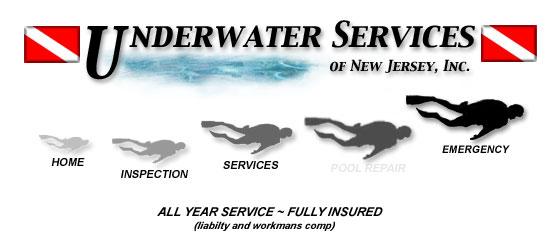
Do I have a leak?, How can I test for leaks?, Where is all this water going?, How can that small hole lose so much water?, How does my leak get fixed?
| Do I have a leak? First, make certain that you have a leak. Mark the height of the water in the skimmer or tile line with a piece of tape or a pencil mark. Watch the water over several days to see if there is a problem. Evaporation can play a significant part of water loss and is increased when the pool is heated. After it is determined by careful observation that there is a leak in your pool contact us. By asking a series of questions we can likely determine the nature of the problem by the symptoms your pool is exhibiting and recommend the next step to take in fixing your problem. Here are a couple of things you can do yourself prior to calling us to determine if there is a legitimate leak and possibly save some money for an unnecessary service call. Back To Top Evaporation Test Fill a large bucket and put on the second step of the pool. Fill the bucket to approximately the same level as the pool. It may be necessary to put something heavy in the bottom of the bucket to prevent it from floating away. Mark the level of the water inside the bucket and the level of the water in the pool. Monitor the water loss over 24 or 48 hours and compare the difference in water loss. Although not foolproof this gives an indication of whether the pool is loosing water from a leak or evaporating. Factors such as heater use and slight differences in water temperature in the pool and the small volume of water in the bucket can skew the results of the test procedure especially when the water loss is marginal. Back To Top Plugging Surface Plumbing The surface plumbing lines are a potential source of water loss that can be easily checked by inserting the winterizing plugs into the lines. This includes skimmers, returns that bring water back into the pool and vacuum lines. Turn off the pool filter and make sure if it is on a timer it will not come back on. This can be done by turning the filter motor off by the circuit breaker. Insert the winterizing plugs into the surface plumbing lines and carefully mark the water level. Monitor the water loss over a 24 or 48 hour period. If the water loss is suspected to be possible evaporation conduct an evaporation test at this time also. If the water level drops with the surface plumbing plugged and the evaporation test indicates the pool is leaking, the source will be somewhere in the pool shell or perhaps a plumbing line not reached from the surface such as a drain or floor return. Now is the time to call us so we can help you solve your leak problem. Back To Top Where is all this water going? The same place it does when it rains, into the ground. Unfortunately the ground under your pool, which in time this water flow can undermine your pool deck and cause structural problems that can eat deeply into your pocketbook. In a vinyl pool an unrepaired leak can wash out the sand or vermiculite under the liner. Sometimes it can turn into an unrepairable problem if ignored for any length of time. Just refilling the pool continually because you have well water or can afford it is not a good idea. A concrete pool can actually rise and float out of the ground when it becomes empty because of a high water table. If you don't think concrete can float up out of the ground concrete ships were built during WWI. One can be seen off of Cape May, NJ where it serves as a breakwater. Back To Top How can that small hole cause me to lose all that water? A hole that a pen can be stuck in can easily account for a loss of two inches a day. Several holes much smaller than that can account for much more of a water loss. Also a liner pool with holes that are not visible to the eye can leak through the material. After years of chemical exposure, ultraviolet light and fluctuating PH the vinyl material breaks down and becomes porous. A liner in this condition can lose a significant amount of water everyday. As the liner weakens with age the amount of force used to clean the liner when it was new and resilient can be enough to puncture the material. If care is taken when vacuuming or brushing the pool this type of damage can be avoided. Back To Top How does my leak get fixed? Leaks in the structure of a concrete pool can usually be repaired with two part epoxy or a combination of materials. Leaking light conduits can be repaired with butyl rubber (weather stripping), epoxy or sometimes a silicone caulk if the light niche is dry. Vinyl pools can be patched underwater. We use a combination of pressure, dye or electronic leak detection to find your problem. Don't ignore your leak problems over the winter. This could mean disaster for your pool. Let us help you protect your valuable investment in your pool. Your pool is supposed to be a source of enjoyment not anxiety we can help you. Back To Top |
|
PO Box 225 Bradley Beach, NJ 07720 www.underwatersvcs.com Phone 732.774.8987 Fax 732-774.6202 Email: kbrennan@underwatersvcs.com |
HOME | INSPECTION | SERVICES | POOL REPAIR | EMERGENCY
webdesign by Michael Parker, www.internetmarquee.com